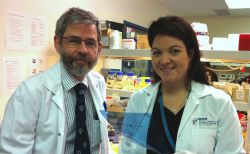
Greater scientific knowledge due to new DNA sequencing technology has prompted a major review of the way researchers are looking at genetic muscle diseases and potential treatments for patients.
Dr Gina Ravenscroft, who is lead author of the review published by the prestigious journal Brain, works in the Neurogenetic Diseases Laboratory at the Harry Perkins Institute of Medical Research; one of the world’s foremost laboratories in the investigation of the genetic causes of muscle diseases.
The muscle diseases investigated by the Laboratory have varying levels of severity but often result in death because the patient’s muscles cannot contract normally. The diseases mainly affect newborn children.
“Traditionally clinicians and researchers have approached these muscle diseases by grouping patients according to the gene or genes which cause the disease,” says Dr Ravenscroft.
“But now that more and more genes are being identified thanks to the new gene sequencing technology, we’re realising that patients may have a mutation in a large number of different genes, which might not have been considered in that disease.”
Dr Ravenscroft says that with expanding knowledge, there’s more overlap between different types of genetic diseases than previously thought.
“We’ve now realised that mutations in many different genes can cause the same type of disease. On the other hand, mutations in the same gene can affect patients differently.”
She says the aim of the review was to look at the pathology, or causes and progression of the diseases and re-think the way that these muscle conditions are grouped.
This might allow researchers to develop new treatments, by using therapies which are applicable to more than one genetic disorder,” she says.
The updated approach explored in the review was first touted during a plenary lecture at the 2012 World Muscle Society Conference, hosted in Perth. The lecturer, Professor Carsten Bonnemann, who is based in the United States, then worked with Dr Ravenscroft and Professor Nigel Laing from the Perkins developing the concept and authoring the review article in Brain.
